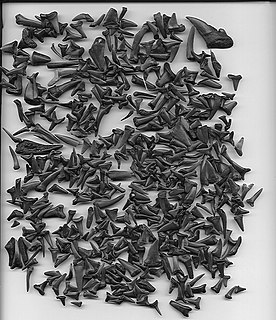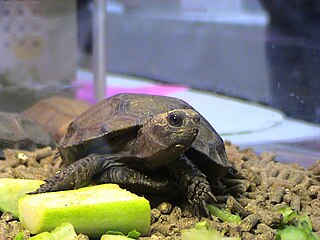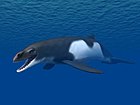
Dinosaurs are a diverse group of reptiles of the clade Dinosauria. They first appeared during the Triassic period, between 243 and 233.23 million years ago, although the exact origin and timing of the evolution of dinosaurs is the subject of active research. They became the dominant terrestrial vertebrates after the Triassic–Jurassic extinction event 201.3 million years ago; their dominance continued throughout the Jurassic and Cretaceous periods. The fossil record shows that birds are modern feathered dinosaurs, having evolved from earlier theropods during the Late Jurassic epoch, and are the only dinosaur lineage known to have survived the Cretaceous–Paleogene extinction event approximately 66 million years ago. Dinosaurs can therefore be divided into avian dinosaurs, or birds; and the extinct non-avian dinosaurs, which are all dinosaurs other than birds.

A fossil is any preserved remains, impression, or trace of any once-living thing from a past geological age. Examples include bones, shells, exoskeletons, stone imprints of animals or microbes, objects preserved in amber, hair, petrified wood, oil, coal, and DNA remnants. The totality of fossils is known as the fossil record.

Paleontology, also spelled palaeontology or palæontology, is the scientific study of life that existed prior to, and sometimes including, the start of the Holocene epoch. It includes the study of fossils to classify organisms and study their interactions with each other and their environments. Paleontological observations have been documented as far back as the 5th century BCE. The science became established in the 18th century as a result of Georges Cuvier's work on comparative anatomy, and developed rapidly in the 19th century. The term itself originates from Greek παλα, ὄν, and λόγος.

A fossil fuel is a hydrocarbon-containing material formed underground from the remains of dead plants and animals that humans extract and burn to release energy for use. The main fossil fuels are coal, petroleum and natural gas, which humans extract through mining and drilling. Fossil fuels may be burnt to provide heat for use directly, to power engines, or to generate electricity.

Ammonoids are a group of extinct marine mollusc animals in the subclass Ammonoidea of the class Cephalopoda. These molluscs, commonly referred to as ammonites, are more closely related to living coleoids than they are to shelled nautiloids such as the living Nautilus species. The earliest ammonites appeared during the Devonian, and the last species either vanished in the Cretaceous–Paleogene extinction event, or shortly after, during the Danian epoch of the Paleocene.

Naracoorte Caves National Park is a national park near Naracoorte in the Limestone Coast tourism region in the south-east of South Australia (Australia). It was officially recognised in 1994 for its extensive fossil record when the site was inscribed on the World Heritage List, along with Riversleigh. The park preserves 6 km2 of remnant vegetation, with 26 caves contained within the 3.05 km2 World Heritage Area. Out of the 28 known caves in the park, only four are open to the public. Other caves are kept away from the public eye as they are important for scientific research and also for the protection of the caves and their contents. Many of the caves contain spectacular stalactites and stalagmites.

A trace fossil, also known as an ichnofossil, is a fossil record of biological activity but not the preserved remains of the plant or animal itself. Trace fossils contrast with body fossils, which are the fossilized remains of parts of organisms' bodies, usually altered by later chemical activity or mineralization. The study of such trace fossils is ichnology and is the work of ichnologists.

Homo is the genus that emerged in the genus Australopithecus that encompasses the extant species Homo sapiens, plus several extinct species classified as either ancestral to or closely related to modern humans, most notably Homo erectus and Homo neanderthalensis. The genus emerged with the appearance of Homo habilis just over 2 million years ago. Homo, together with the genus Paranthropus, is probably sister to Australopithecus africanus, which itself had previously split from the lineage of Pan, the chimpanzees.

Fossil collecting is the collection of fossils for scientific study, hobby, or profit. Fossil collecting, as practiced by amateurs, is the predecessor of modern paleontology and many still collect fossils and study fossils as amateurs. Professionals and amateurs alike collect fossils for their scientific value. A commercial trade in fossils has also long existed, with some of this being practised illegally.

Struthio is a genus of birds in the order Struthioniformes, whose members are the ostriches. It is part of the infra-class Palaeognathae, a diverse group of flightless birds also known as ratites that includes the emus, rheas, and kiwis. There are two living species of ostrich: the common ostrich and the Somali ostrich. They are large flightless birds of Africa who lay the largest eggs of any living land animal. With the ability to run at 70 km/h (43.5 mph), they are the fastest birds on land. They are farmed worldwide, particularly for their feathers as they are used as decoration and feather dusters. Their skin is also used for leather products. Ostriches are notable for being the heaviest living birds.

AL 288-1, commonly known as Lucy, is a collection of several hundred pieces of fossilized bone representing 40 percent of a female of the hominin species Australopithecus afarensis. In Ethiopia, the assembly is also known as Dinkinesh, which means "you are marvelous" in Amharic. Lucy was discovered in 1974 in Africa, at Hadar, a site in the Awash Valley of the Afar Triangle in Ethiopia, by paleoanthropologist Donald Johanson of the Cleveland Museum of Natural History.

The Ediacaranbiota is a taxonomic period classification that consists of all life forms that were present on Earth during the Ediacaran Period. These were composed of enigmatic tubular and frond-shaped, mostly sessile, organisms. Trace fossils of these organisms have been found worldwide, and represent the earliest known complex multicellular organisms.

Manouria is a genus of tortoises in the family Testudinidae. The genus was erected by John Edward Gray in 1854.
Elsornis is a genus of enantiornithine bird. Only one species is known, Elsornis keni. It lived during the Late Cretaceous. It is known from a partially articulated fossil skeleton found in the Gobi Desert in Mongolia.
The Cambrian explosion, Cambrian radiation,Cambrian diversification, or The Biological Big Bang refers to an interval of time approximately 541 million years ago in the Cambrian Period when practically all major animal phyla started appearing in the fossil record. It lasted for about 13 – 25 million years and resulted in the divergence of most modern metazoan phyla. The event was accompanied by major diversification in other groups of organisms as well.
Caririemys is an extinct genus of side-necked turtles, belonging to the Pelomedusoides of the family Euraxemydidae. The type species is C. violetae. A single fossil of an individual was found in the Santana Formation in Brazil, an 80-million-year-old Late Cretaceous deposit that has so far preserved other fossil reptiles such as dinosaurs and crocodilians.

A fuel is any material that can be made to react with other substances so that it releases energy as thermal energy or to be used for work. The concept was originally applied solely to those materials capable of releasing chemical energy but has since also been applied to other sources of heat energy such as nuclear energy.
Banksia novae-zelandiae is an extinct species of Banksia, known only from fossil leaves found in the South Island of New Zealand.


















